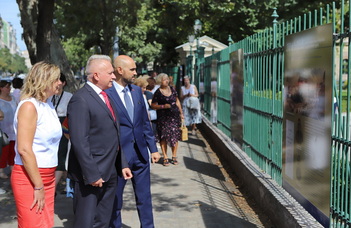Exhibition opened in connection with the symposium of European archaeologists
In 2022, the annual conference of the European Association of Archaeologists (EAA) was hosted by ELTE, the Hungarian National Museum, and the Castle Headquarters Nonprofit Ltd. Approximately 1,700 archaeologists from over sixty countries were expected to attend the symposium. On the occasion of the event, an exhibition entitled “A country of archaeological wonders – national image in 1876” was displayed on the fence of the Hungarian National Museum, which was shown to the representatives of the press on 29 August by László Borhy, Rector of Eötvös Loránd University, and Gábor Virágos, Deputy Director-General of Archaeology of the Hungarian National Museum.
László Borhy referred to the archaeological congress organised in the 19th century at the initiative of Flóris Rómer, chaired by Ferenc Pulszky, and opened by Ágoston Trefort. That conference was attended by hundreds of researchers from Europe. Although several outstanding archaeological and anthropological events took place in Hungary in the past – the 2001 International Congress on Ancient Wall Painting, for example, was hosted by ELTE – no symposium comparable to the scale of the annual conference of the European Association of Archaeologists has been held in the country since the 19th century. László Borhy emphasised that the EAA conference represents a great opportunity for the profession of archaeology as well as the universities in Hungary. The organisation of this significant event comprising six sessions commenced seven years ago, but the pandemic halted the process.
As Gábor Virágos, Deputy Director-General of the Hungarian National Museum highlighted, the Carpathian Basin, and within that, the area of historical and present-day Hungary was a place where innovations having fundamental importance for the entire humanity were passed on in several archaeological and historical eras, which is why this country offers unique opportunities in the field of archaeology too. With the exhibition, the organisers wanted to draw the attention of as many interested people as possible to the archaeological heritage of Hungary and the current conference. Cultural heritage protection and archaeology are facing enormous challenges all over the world: research is affected by globalisation, climate change, and economic recession, added the Deputy Director-General, and the symposium held in Budapest was also of considerable importance in this regard.
The exhibition was arranged by Judit P. Barna, archaeologist, head of the Community Engagement and Public Relations Unit at the Archaeological Heritage Directorate of the Hungarian National Museum, National Institute of Archaeology, and Péter Prohászka, scientific research associate at the Nitra Institute of Archaeology at the Slovak Academy of Sciences. Its title evokes a nineteenth-century report: Norwegian archaeologist Ingvald Undset referred to Hungary as “the country of archaeological wonders” based on what he experienced at the 1876 congress.
The exhibition can be seen on the fence of the Hungarian National Museum on Múzeum Boulevard.

